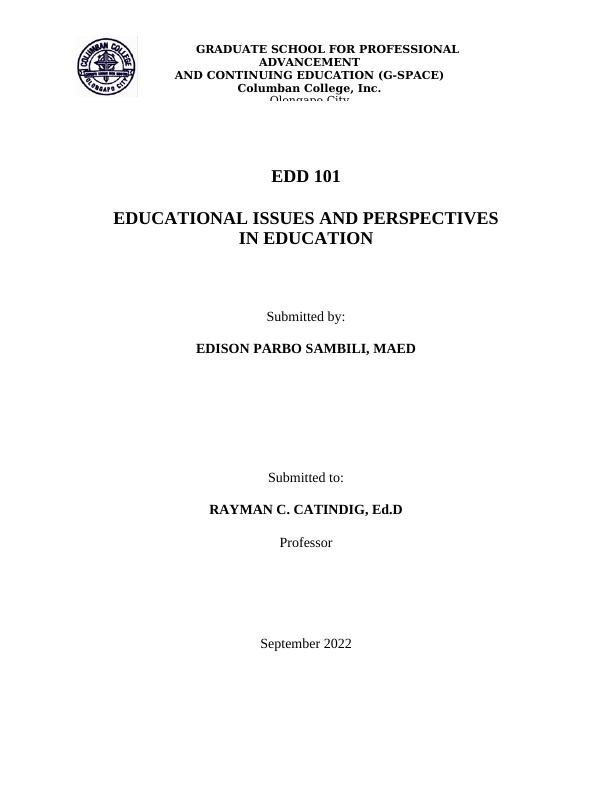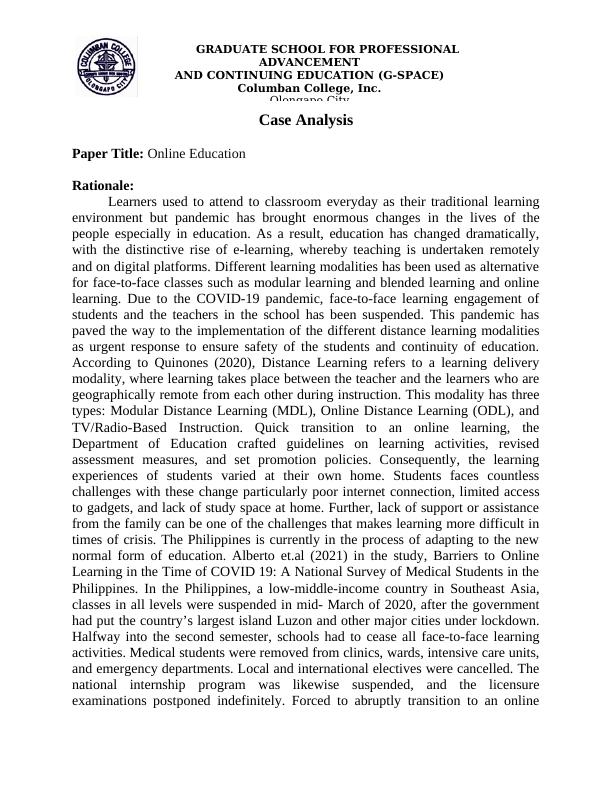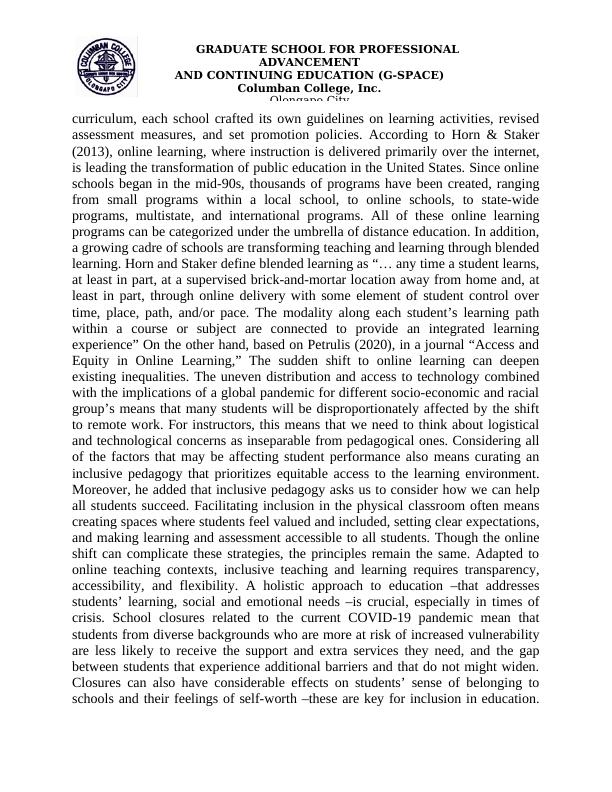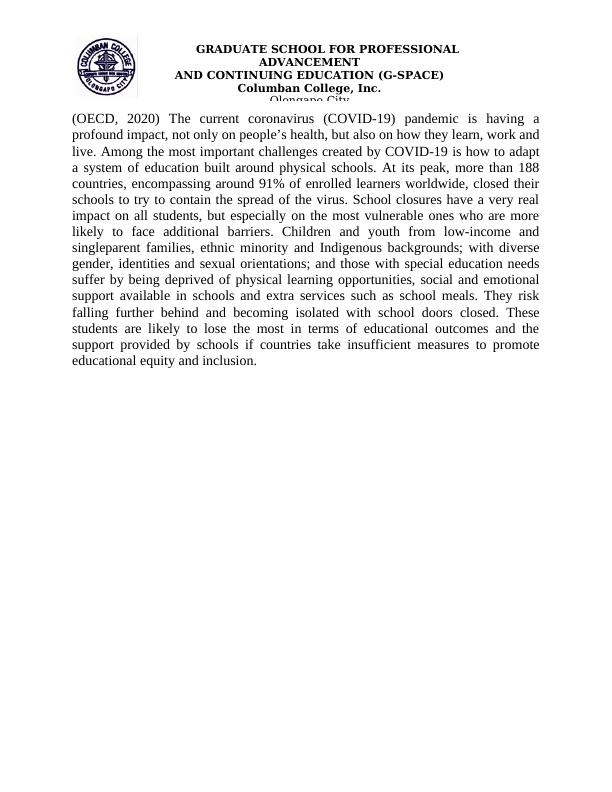Online Education: Implications and Challenges in the Philippines
12 Pages5247 Words56 Views
Added on 2023-01-13
About This Document
This paper discusses the implications and challenges of online education in the Philippines during the COVID-19 pandemic. It explores the shift to distance learning, the barriers faced by students, and the importance of equity and access in online education. The paper emphasizes the need for professional and equitable online learning practices.
Online Education: Implications and Challenges in the Philippines
Added on 2023-01-13
ShareRelated Documents
GRADUATE SCHOOL FOR PROFESSIONAL
ADVANCEMENT
AND CONTINUING EDUCATION (G-SPACE)
Columban College, Inc.
Olongapo City
EDD 101
EDUCATIONAL ISSUES AND PERSPECTIVES
IN EDUCATION
Submitted by:
EDISON PARBO SAMBILI, MAED
Submitted to:
RAYMAN C. CATINDIG, Ed.D
Professor
September 2022
ADVANCEMENT
AND CONTINUING EDUCATION (G-SPACE)
Columban College, Inc.
Olongapo City
EDD 101
EDUCATIONAL ISSUES AND PERSPECTIVES
IN EDUCATION
Submitted by:
EDISON PARBO SAMBILI, MAED
Submitted to:
RAYMAN C. CATINDIG, Ed.D
Professor
September 2022

GRADUATE SCHOOL FOR PROFESSIONAL
ADVANCEMENT
AND CONTINUING EDUCATION (G-SPACE)
Columban College, Inc.
Olongapo City
Case Analysis
Paper Title: Online Education
Rationale:
Learners used to attend to classroom everyday as their traditional learning
environment but pandemic has brought enormous changes in the lives of the
people especially in education. As a result, education has changed dramatically,
with the distinctive rise of e-learning, whereby teaching is undertaken remotely
and on digital platforms. Different learning modalities has been used as alternative
for face-to-face classes such as modular learning and blended learning and online
learning. Due to the COVID-19 pandemic, face-to-face learning engagement of
students and the teachers in the school has been suspended. This pandemic has
paved the way to the implementation of the different distance learning modalities
as urgent response to ensure safety of the students and continuity of education.
According to Quinones (2020), Distance Learning refers to a learning delivery
modality, where learning takes place between the teacher and the learners who are
geographically remote from each other during instruction. This modality has three
types: Modular Distance Learning (MDL), Online Distance Learning (ODL), and
TV/Radio-Based Instruction. Quick transition to an online learning, the
Department of Education crafted guidelines on learning activities, revised
assessment measures, and set promotion policies. Consequently, the learning
experiences of students varied at their own home. Students faces countless
challenges with these change particularly poor internet connection, limited access
to gadgets, and lack of study space at home. Further, lack of support or assistance
from the family can be one of the challenges that makes learning more difficult in
times of crisis. The Philippines is currently in the process of adapting to the new
normal form of education. Alberto et.al (2021) in the study, Barriers to Online
Learning in the Time of COVID 19: A National Survey of Medical Students in the
Philippines. In the Philippines, a low-middle-income country in Southeast Asia,
classes in all levels were suspended in mid- March of 2020, after the government
had put the country’s largest island Luzon and other major cities under lockdown.
Halfway into the second semester, schools had to cease all face-to-face learning
activities. Medical students were removed from clinics, wards, intensive care units,
and emergency departments. Local and international electives were cancelled. The
national internship program was likewise suspended, and the licensure
examinations postponed indefinitely. Forced to abruptly transition to an online
ADVANCEMENT
AND CONTINUING EDUCATION (G-SPACE)
Columban College, Inc.
Olongapo City
Case Analysis
Paper Title: Online Education
Rationale:
Learners used to attend to classroom everyday as their traditional learning
environment but pandemic has brought enormous changes in the lives of the
people especially in education. As a result, education has changed dramatically,
with the distinctive rise of e-learning, whereby teaching is undertaken remotely
and on digital platforms. Different learning modalities has been used as alternative
for face-to-face classes such as modular learning and blended learning and online
learning. Due to the COVID-19 pandemic, face-to-face learning engagement of
students and the teachers in the school has been suspended. This pandemic has
paved the way to the implementation of the different distance learning modalities
as urgent response to ensure safety of the students and continuity of education.
According to Quinones (2020), Distance Learning refers to a learning delivery
modality, where learning takes place between the teacher and the learners who are
geographically remote from each other during instruction. This modality has three
types: Modular Distance Learning (MDL), Online Distance Learning (ODL), and
TV/Radio-Based Instruction. Quick transition to an online learning, the
Department of Education crafted guidelines on learning activities, revised
assessment measures, and set promotion policies. Consequently, the learning
experiences of students varied at their own home. Students faces countless
challenges with these change particularly poor internet connection, limited access
to gadgets, and lack of study space at home. Further, lack of support or assistance
from the family can be one of the challenges that makes learning more difficult in
times of crisis. The Philippines is currently in the process of adapting to the new
normal form of education. Alberto et.al (2021) in the study, Barriers to Online
Learning in the Time of COVID 19: A National Survey of Medical Students in the
Philippines. In the Philippines, a low-middle-income country in Southeast Asia,
classes in all levels were suspended in mid- March of 2020, after the government
had put the country’s largest island Luzon and other major cities under lockdown.
Halfway into the second semester, schools had to cease all face-to-face learning
activities. Medical students were removed from clinics, wards, intensive care units,
and emergency departments. Local and international electives were cancelled. The
national internship program was likewise suspended, and the licensure
examinations postponed indefinitely. Forced to abruptly transition to an online

GRADUATE SCHOOL FOR PROFESSIONAL
ADVANCEMENT
AND CONTINUING EDUCATION (G-SPACE)
Columban College, Inc.
Olongapo City
curriculum, each school crafted its own guidelines on learning activities, revised
assessment measures, and set promotion policies. According to Horn & Staker
(2013), online learning, where instruction is delivered primarily over the internet,
is leading the transformation of public education in the United States. Since online
schools began in the mid-90s, thousands of programs have been created, ranging
from small programs within a local school, to online schools, to state-wide
programs, multistate, and international programs. All of these online learning
programs can be categorized under the umbrella of distance education. In addition,
a growing cadre of schools are transforming teaching and learning through blended
learning. Horn and Staker define blended learning as “... any time a student learns,
at least in part, at a supervised brick-and-mortar location away from home and, at
least in part, through online delivery with some element of student control over
time, place, path, and/or pace. The modality along each student’s learning path
within a course or subject are connected to provide an integrated learning
experience” On the other hand, based on Petrulis (2020), in a journal “Access and
Equity in Online Learning,” The sudden shift to online learning can deepen
existing inequalities. The uneven distribution and access to technology combined
with the implications of a global pandemic for different socio-economic and racial
group’s means that many students will be disproportionately affected by the shift
to remote work. For instructors, this means that we need to think about logistical
and technological concerns as inseparable from pedagogical ones. Considering all
of the factors that may be affecting student performance also means curating an
inclusive pedagogy that prioritizes equitable access to the learning environment.
Moreover, he added that inclusive pedagogy asks us to consider how we can help
all students succeed. Facilitating inclusion in the physical classroom often means
creating spaces where students feel valued and included, setting clear expectations,
and making learning and assessment accessible to all students. Though the online
shift can complicate these strategies, the principles remain the same. Adapted to
online teaching contexts, inclusive teaching and learning requires transparency,
accessibility, and flexibility. A holistic approach to education –that addresses
students’ learning, social and emotional needs –is crucial, especially in times of
crisis. School closures related to the current COVID-19 pandemic mean that
students from diverse backgrounds who are more at risk of increased vulnerability
are less likely to receive the support and extra services they need, and the gap
between students that experience additional barriers and that do not might widen.
Closures can also have considerable effects on students’ sense of belonging to
schools and their feelings of self-worth –these are key for inclusion in education.
ADVANCEMENT
AND CONTINUING EDUCATION (G-SPACE)
Columban College, Inc.
Olongapo City
curriculum, each school crafted its own guidelines on learning activities, revised
assessment measures, and set promotion policies. According to Horn & Staker
(2013), online learning, where instruction is delivered primarily over the internet,
is leading the transformation of public education in the United States. Since online
schools began in the mid-90s, thousands of programs have been created, ranging
from small programs within a local school, to online schools, to state-wide
programs, multistate, and international programs. All of these online learning
programs can be categorized under the umbrella of distance education. In addition,
a growing cadre of schools are transforming teaching and learning through blended
learning. Horn and Staker define blended learning as “... any time a student learns,
at least in part, at a supervised brick-and-mortar location away from home and, at
least in part, through online delivery with some element of student control over
time, place, path, and/or pace. The modality along each student’s learning path
within a course or subject are connected to provide an integrated learning
experience” On the other hand, based on Petrulis (2020), in a journal “Access and
Equity in Online Learning,” The sudden shift to online learning can deepen
existing inequalities. The uneven distribution and access to technology combined
with the implications of a global pandemic for different socio-economic and racial
group’s means that many students will be disproportionately affected by the shift
to remote work. For instructors, this means that we need to think about logistical
and technological concerns as inseparable from pedagogical ones. Considering all
of the factors that may be affecting student performance also means curating an
inclusive pedagogy that prioritizes equitable access to the learning environment.
Moreover, he added that inclusive pedagogy asks us to consider how we can help
all students succeed. Facilitating inclusion in the physical classroom often means
creating spaces where students feel valued and included, setting clear expectations,
and making learning and assessment accessible to all students. Though the online
shift can complicate these strategies, the principles remain the same. Adapted to
online teaching contexts, inclusive teaching and learning requires transparency,
accessibility, and flexibility. A holistic approach to education –that addresses
students’ learning, social and emotional needs –is crucial, especially in times of
crisis. School closures related to the current COVID-19 pandemic mean that
students from diverse backgrounds who are more at risk of increased vulnerability
are less likely to receive the support and extra services they need, and the gap
between students that experience additional barriers and that do not might widen.
Closures can also have considerable effects on students’ sense of belonging to
schools and their feelings of self-worth –these are key for inclusion in education.

GRADUATE SCHOOL FOR PROFESSIONAL
ADVANCEMENT
AND CONTINUING EDUCATION (G-SPACE)
Columban College, Inc.
Olongapo City
(OECD, 2020) The current coronavirus (COVID-19) pandemic is having a
profound impact, not only on people’s health, but also on how they learn, work and
live. Among the most important challenges created by COVID-19 is how to adapt
a system of education built around physical schools. At its peak, more than 188
countries, encompassing around 91% of enrolled learners worldwide, closed their
schools to try to contain the spread of the virus. School closures have a very real
impact on all students, but especially on the most vulnerable ones who are more
likely to face additional barriers. Children and youth from low-income and
singleparent families, ethnic minority and Indigenous backgrounds; with diverse
gender, identities and sexual orientations; and those with special education needs
suffer by being deprived of physical learning opportunities, social and emotional
support available in schools and extra services such as school meals. They risk
falling further behind and becoming isolated with school doors closed. These
students are likely to lose the most in terms of educational outcomes and the
support provided by schools if countries take insufficient measures to promote
educational equity and inclusion.
ADVANCEMENT
AND CONTINUING EDUCATION (G-SPACE)
Columban College, Inc.
Olongapo City
(OECD, 2020) The current coronavirus (COVID-19) pandemic is having a
profound impact, not only on people’s health, but also on how they learn, work and
live. Among the most important challenges created by COVID-19 is how to adapt
a system of education built around physical schools. At its peak, more than 188
countries, encompassing around 91% of enrolled learners worldwide, closed their
schools to try to contain the spread of the virus. School closures have a very real
impact on all students, but especially on the most vulnerable ones who are more
likely to face additional barriers. Children and youth from low-income and
singleparent families, ethnic minority and Indigenous backgrounds; with diverse
gender, identities and sexual orientations; and those with special education needs
suffer by being deprived of physical learning opportunities, social and emotional
support available in schools and extra services such as school meals. They risk
falling further behind and becoming isolated with school doors closed. These
students are likely to lose the most in terms of educational outcomes and the
support provided by schools if countries take insufficient measures to promote
educational equity and inclusion.

End of preview
Want to access all the pages? Upload your documents or become a member.
Related Documents
e-Learning in Nursing Educationlg...
|10
|2180
|111
Academic Study Skills: Advantages and Disadvantages of Online Learninglg...
|11
|3542
|479
